
The Intermediate-Range Nuclear Forces Treaty was an arms control treaty between the United States and the Soviet Union. US President Ronald Reagan and Soviet General Secretary Mikhail Gorbachev signed the treaty on 8 December 1987. The US Senate approved the treaty on 27 May 1988, and Reagan and Gorbachev ratified it on 1 June 1988.

The RSD-10 Pioneer was an intermediate-range ballistic missile with a nuclear warhead, deployed by the Soviet Union from 1976 to 1988. It carried GRAU designation 15Ж45 (15Zh45). Its NATO reporting name was SS-20 Saber.
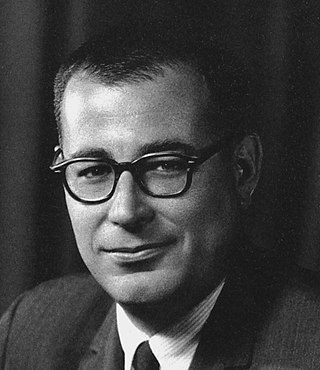
Harold Brown was an American nuclear physicist who served as United States Secretary of Defense from 1977 to 1981, under President Jimmy Carter. Previously, in the John F. Kennedy and Lyndon B. Johnson administrations, he held the posts of Director of Defense Research and Engineering (1961–1965) and United States Secretary of the Air Force (1965–1969).

The People's Republic of China has developed and possesses weapons of mass destruction, including chemical and nuclear weapons. The first of China's nuclear weapons tests took place in 1964, and its first hydrogen bomb test occurred in 1966 at Lop Nur. Tests continued until 1996, when the country signed the Comprehensive Nuclear-Test-Ban Treaty (CTBT), but did not ratify it. China acceded to the Biological Weapons Convention (BWC) in 1984 and ratified the Chemical Weapons Convention (CWC) in 1997.
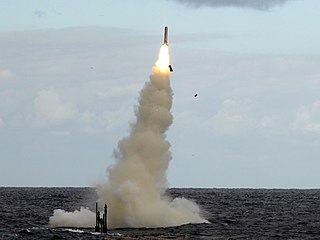
A submarine-launched cruise missile (SLCM) is a cruise missile that is launched from a submarine. Current versions are typically standoff weapons known as land-attack cruise missiles (LACMs), which are used to attack predetermined land targets with conventional or nuclear payloads. Anti-ship cruise missiles (ASCMs) are also used, and some submarine-launched cruise missiles have variants for both functions.
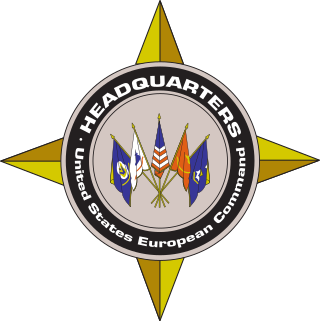
The United States European Command (EUCOM) is one of the eleven unified combatant commands of the United States military, headquartered in Stuttgart, Germany. Its area of focus covers 21,000,000 square miles (54,000,000 km2) and 51 countries and territories, including Europe, The Caucasus, Russia and Greenland. The Commander of the United States EUCOM simultaneously serves as the Supreme Allied Commander, Europe (SACEUR) within NATO, a military alliance. During the Gulf War and Operation Northern Watch, EUCOM controlled the forces flying from Incirlik Air Base.
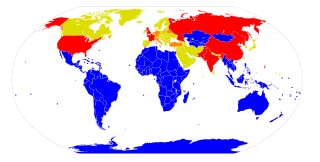
Nuclear sharing is a concept in NATO's policy of nuclear deterrence, which allows member countries without nuclear weapons of their own to participate in the planning for the use of nuclear weapons by NATO. In particular, it provides for involvement of the armed forces of those countries in delivering nuclear weapons in the event of their use.
Able Archer 83 was a military exercise conducted by NATO that took place in November 1983. It simulated a period of heightened nuclear tensions between NATO and the Warsaw Pact, leading to concerns that it could have been mistaken for a real attack by the Soviet Union. The exercise is considered by some to be one of the closest moments the world came to nuclear war during the Cold War. It was the annual Able Archer exercise conducted in November 1983. The purpose of the exercise, like previous years, was to simulate a period of conflict escalation, culminating in the US military attaining a simulated DEFCON 1 coordinated nuclear attack. The five-day exercise, which involved NATO commands throughout Western Europe, was coordinated from the Supreme Headquarters Allied Powers Europe (SHAPE) headquarters in Casteau, Belgium.

The TR-1 Temp was a mobile theatre ballistic missile developed and deployed by the Soviet Union during the Cold War. It was assigned the NATO reporting name SS-12 Scaleboard and carried the industrial designation 9M76 and the GRAU index 9К76. A modified version was initially identified by NATO as a new design and given the SS-22 reporting name, but later recognized it as merely a variant of the original and maintained the name Scaleboard. The Temp entered service in the mid-1960s.

The Ground Launched Cruise Missile, or GLCM, was a ground-launched cruise missile developed by the United States Air Force in the last decade of the Cold War and disarmed under the INF Treaty.
START III was a proposed bilateral arms control treaty between the United States and Russia that was meant to reduce the deployed nuclear weapons arsenals of both countries drastically and to continue the weapons reduction efforts that had taken place in the START I and START II negotiations. The framework for negotiations of the treaty began with talks in Helsinki between US President Bill Clinton and Russian President Boris Yeltsin in 1997. However, negotiations broke down, and the treaty was never signed.

The Cold War from 1979 to 1985 was a late phase of the Cold War marked by a sharp increase in hostility between the Soviet Union and the West. It arose from a strong denunciation of the Soviet invasion of Afghanistan in December 1979. With the election of Prime Minister Margaret Thatcher in 1979, and American President Ronald Reagan in 1980, a corresponding change in Western foreign policy approach toward the Soviet Union was marked by the rejection of détente in favor of the Reagan Doctrine policy of rollback, with the stated goal of dissolving Soviet influence in Soviet Bloc countries. During this time, the threat of nuclear war had reached new heights not seen since the Cuban Missile Crisis of 1962.

The 38th Combat Support Wing is an inactive wing of the United States Air Force. Its last assignment was with Third Air Force at Ramstein Air Base, Germany from 2004 until 2007. The mission of the wing was to enhance support to Third Air Force's geographically separated units.
On 26 September 1983, during the Cold War, the Soviet nuclear early warning system Oko reported the launch of one intercontinental ballistic missile with four more missiles behind it, from the United States. These missile attack warnings were suspected to be false alarms by Stanislav Petrov, an engineer of the Soviet Air Defence Forces on duty at the command center of the early-warning system. He decided to wait for corroborating evidence—of which none arrived—rather than immediately relaying the warning up the chain of command. This decision is seen as having prevented a retaliatory nuclear strike against the United States and its NATO allies, which would likely have resulted in a full-scale nuclear war. Investigation of the satellite warning system later determined that the system had indeed malfunctioned.
This Pershing missile bibliography is a list of works related to the Pershing 1 and Pershing 1a Field Artillery Missile Systems and the Pershing II Weapon System.
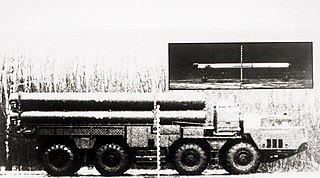
The Novator RK-55 Relief is a Russian Navy cruise missile that is launched either from submarines (SLCM) or from surface ships. It can have a nuclear warhead developed in the Soviet Union. A version launched from submarine torpedo tubes, the S-10 Granat, has apparently been converted to carry conventional warheads and continues in service to this day. The Russian Federation was reported to have deployed the derivative SS-CX-7/SS-CX-8 systems on 14 February 2017. The land launched version is called the Novator 9M729.
This timeline of nuclear weapons development is a chronological catalog of the evolution of nuclear weapons rooting from the development of the science surrounding nuclear fission and nuclear fusion. In addition to the scientific advancements, this timeline also includes several political events relating to the development of nuclear weapons. The availability of intelligence on recent advancements in nuclear weapons of several major countries is limited because of the classification of technical knowledge of nuclear weapons development.
The "Zero Option" was the name given to an American proposal for the withdrawal of all Soviet and United States intermediate-range nuclear missiles from Europe. This term was subsequently expanded to describe the vision of eliminating all nuclear weapons everywhere.

The Pershing II Weapon System was a solid-fueled two-stage medium-range ballistic missile designed and built by Martin Marietta to replace the Pershing 1a Field Artillery Missile System as the United States Army's primary nuclear-capable theater-level weapon. The U.S. Army replaced the Pershing 1a with the Pershing II Weapon System in 1983, while the German Air Force retained Pershing 1a until all Pershings were eliminated in 1991. The U.S. Army Missile Command (MICOM) managed the development and improvements, while the Field Artillery Branch deployed the systems and developed tactical doctrine.

The Kh-80 Meteorit-A, the RK-75 Meteorit-N(GRAU:3M25N, NATO:SS-NX-24 Scorpion) and the P-750 Meteorit-M was a Soviet cruise missile which was supposed to replace subsonic intermediate range missiles in Soviet inventory.















